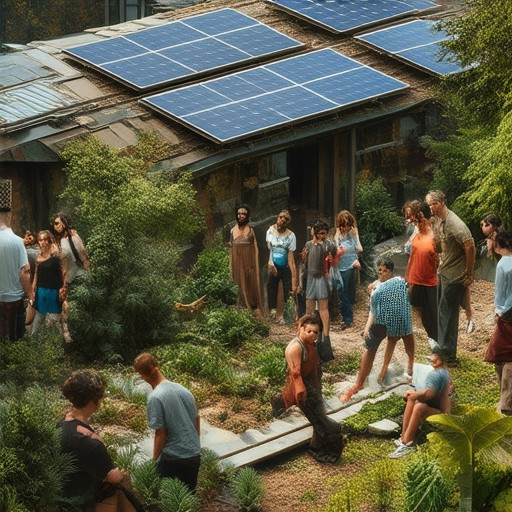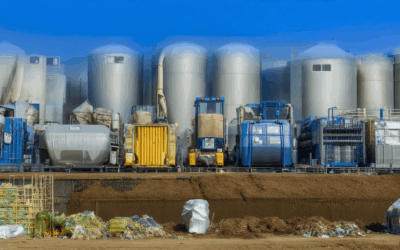Are you ready to transform your community into a model of efficiency? In today’s fast-paced world, where environmental challenges loom large and resources seem increasingly scarce, the concept of resource-efficient community living has never been more relevant. Cities and communities worldwide are embracing innovative strategies to reduce waste, conserve energy, and create sustainable systems that benefit both residents and the planet. By fostering resource-efficient practices, we not only protect our environment but also lay the foundation for long-term economic stability and social equity. This article delves into the innovative strategies being employed across the globe to achieve resource-efficient community living, highlighting how these efforts are reshaping modern living standards.

How to Make Your Community More Resource-Efficient
To make your community more resource-efficient, consider implementing the following strategies:
- Promote Renewable Energy Sources : Encourage the installation of solar panels and wind turbines in residential and commercial areas. Consider forming a community solar farm cooperative where members can subscribe to share the benefits of renewable energy.
- Implement Comprehensive Recycling Programs : Establish recycling centers and organize regular cleanup drives to reduce waste. Introduce incentives for households that properly segregate recyclables and compostables.
- Adopt Water Conservation Measures : Install low-flow fixtures in public spaces and schools. Launch awareness campaigns about water conservation to encourage responsible usage. Install rainwater harvesting systems to supplement community water supplies during dry seasons.
- Support Sustainable Transportation : Advocate for public transit options, bike-sharing programs, and carpooling services. Set up charging stations for electric vehicles to promote cleaner transportation choices.
- Develop Green Infrastructure : Construct green roofs on public buildings to manage stormwater and reduce urban heat island effects. Use permeable pavements and landscaping to enhance water drainage and aesthetic appeal.
- Educate and Engage Residents : Host workshops and seminars on energy-saving techniques, sustainable agriculture, and eco-friendly practices. Incorporate sustainability into school curricula to foster early interest in resource efficiency among youth.
- Collaborate with Local Governments and NGOs : Partner with municipal authorities and non-profits to leverage existing resources and expertise. Seek grants and funding opportunities to support community projects focused on sustainability.
- Monitor and Evaluate Progress : Track key metrics such as energy savings, waste reduction, and water usage to measure the effectiveness of your initiatives. Celebrate successful programs to inspire continued participation and innovation.
By combining these approaches, your community can become a model of resource efficiency, benefiting both the environment and its residents.
Effective Ways to Promote Resource-Efficient Community Living
Resource-efficient living is essential for creating a sustainable future. Here are proven strategies to encourage your community to adopt eco-friendly practices:
- Education and Awareness Campaigns : Host workshops, seminars, and events to educate residents about resource efficiency. Share tips on reducing waste, conserving water, and optimizing energy use through interactive sessions and informational materials.
- Community Initiatives : Launch collaborative projects like recycling drives, composting programs, and energy-saving competitions. Engage local businesses and schools to amplify impact and participation.
- Incentives and Rewards : Offer financial incentives or rewards for households that adopt resource-efficient practices. Examples include rebates for installing solar panels or discounts on energy-efficient appliances.
- Model Homes and Demonstration Projects : Build or renovate model homes that showcase resource-efficient designs. Tours and open houses can inspire others to adopt similar practices.
- Public Partnerships : Collaborate with local governments, NGOs, and educational institutions to leverage resources and expertise. Shared efforts can lead to more successful outcomes.
- Technology Integration : Utilize digital tools and apps to track resource usage and share best practices. Platforms like Pyrolysium offer innovative solutions for waste management and energy optimization.
- Volunteer Programs : Organize volunteer teams to assist neighbors with implementing resource-efficient measures. Building a sense of community can motivate continued participation and innovation.
By working together, communities can achieve remarkable results in promoting resource efficiency. Small, collective actions can lead to significant environmental and social benefits for generations to come.

Improving Resource Efficiency in Your Community
Resource efficiency is a cornerstone of sustainable living, enabling communities to make the most of available resources while minimizing environmental impact. Here are some effective strategies to enhance resource efficiency:
- Waste Reduction and Management:
- Implement comprehensive recycling programs.
- Adopt composting initiatives for organic waste.
- Explore waste-to-energy solutions.
- Energy Efficiency:
- Promote solar and wind energy installations.
- Encourage carpooling and public transportation use.
- Install energy-efficient lighting and appliances in public spaces.
- Water Conservation:
- Install drip irrigation systems for agriculture.
- Harvest rainwater for household and communal use.
- Introduce water-saving devices in public facilities.
- Sustainable Infrastructure:
- Construct permeable surfaces in parking lots and roads.
- Install green roofs to manage stormwater and insulate buildings.
- Develop pedestrian and cycling pathways to reduce vehicle dependency.
- Economic Sustainability:
- Support local businesses adopting eco-friendly practices.
- Promote circular economy principles, such as product repair and reuse.
- Advocate for policies encouraging green building and sustainable manufacturing.
- Community Education:
- Organize workshops on energy-saving techniques and sustainable farming.
- Establish community centers as hubs for environmental education.
- Develop youth programs to engage the next generation in sustainability efforts.
- Partnerships and Collaboration:
- Form alliances between governments, NGOs, businesses, and residents.
- Seek grants and funding from organizations specializing in sustainability.
- Engage volunteers to assist in implementing community projects.
- Technology Integration:
- Deploy smart grid systems for efficient energy distribution.
- Use apps to monitor and optimize resource usage.
- Investigate the use of blockchain for tracking resource flows and reducing waste.
- Measurement and Accountability:
- Track metrics such as waste reduction rates and energy savings.
- Report progress publicly to maintain transparency and accountability.
- Recognize and celebrate community achievements to foster continued engagement.
By integrating these strategies, your community can significantly enhance its resource efficiency, paving the way for a more sustainable and resilient future. Start with pilot projects, engage your neighbors, and build upon proven successes to create a model of efficiency and sustainability.

What Are the Best Practices for Creating a Resource-Efficient Community?
Creating a resource-efficient community involves thoughtful planning and sustainable practices to maximize the use of available resources while minimizing waste and environmental impact. Below are key strategies to achieve this goal:
- Design Compact Layouts Near Amenities
- Integrate Renewable Energy Systems
- Use Sustainable Building Materials
- Implement Water Conservation Strategies
- Foster Eco-Friendly Habits Through Education and Incentives
Planning communities close to schools, workplaces, and public transportation reduces the need for extensive commuting, lowering energy consumption and carbon emissions.
Utilizing solar panels, wind turbines, and geothermal systems can significantly reduce reliance on non-renewable energy sources, promoting a cleaner environment.
Constructing buildings with materials like recycled steel, bamboo, and low-VOC paints can minimize environmental impact while maintaining durability and aesthetics.
Install rainwater harvesting systems and use greywater recycling to conserve water, reducing the strain on local water supplies.
Community programs, workshops, and incentives can encourage residents to adopt sustainable practices, such as composting, recycling, and energy-saving behaviors.
By integrating these strategies, communities can become models of resource efficiency, setting a standard for sustainable living and contributing positively to environmental stewardship. For more insights and tools to support your journey, visit our sustainable living resources .
Effective Methods for Resource-Efficient Community Living
Resource-efficient community living involves adopting practices that minimize waste, conserve resources, and promote sustainability. Here are some proven methods:
- Reduce Waste: Implement recycling programs, composting initiatives, and waste reduction campaigns. Encourage the use of reusable items like cloth bags, water bottles, and food containers.
- Conserve Water: Install low-flow fixtures, harvest rainwater, and promote water-saving irrigation techniques for landscaping and agriculture.
- Boost Energy Efficiency: Transition to renewable energy sources like solar power, install energy-efficient appliances, and establish community solar farms for shared use.
- Sustainable Transportation: Promote carpooling, public transit use, and bike-sharing programs to reduce the reliance on private vehicles.
- Sustainable Building Practices: Construct buildings using recycled materials and incorporate passive design principles to reduce energy consumption. Install green roofs and engage in local food production to decrease transportation-related emissions.
- Community Engagement: Organize educational workshops, awareness campaigns, and collaborative projects to inspire residents to take action and share resources effectively.
- Technology Integration: Utilize smart grids and IoT-enabled devices to monitor and manage energy and water usage in real-time, ensuring efficient resource allocation.
- Policy and Infrastructure Support: Advocate for local policies that promote zero-waste initiatives and invest in green spaces and community gardens to enhance resource efficiency.
By combining these methods, communities can create a more resource-efficient and sustainable living environment, fostering a culture of responsibility and innovation among its members.

How to Make Your Community More Resource-Efficient
To make your community more resource-efficient, consider implementing the following strategies:
- Promote Renewable Energy Usage :
- Install solar panels or wind turbines in public spaces or encourage residents to do so on their properties.
- Provide incentives or subsidies for installing renewable energy systems.
- Conduct energy audits to identify areas for improvement in residential and commercial buildings.
- Implement Water Conservation Measures :
- Set up rainwater harvesting systems to collect and store rainwater for non-potable uses like irrigation or landscaping.
- Develop water-saving irrigation systems for public spaces and parks.
- Educate residents on water-saving techniques through workshops and informational materials.
- Enhance Waste Reduction and Recycling Programs :
- Roll out curbside recycling and composting programs to reduce landfill waste.
- Host community clean-up drives and educational sessions on proper waste disposal methods.
- Promote the separation of recyclables and organic waste through public awareness campaigns.
- Encourage Sustainable Transportation :
- Expand public transportation routes and services to make them more accessible.
- Create carpooling networks or bike-sharing programs to reduce the number of vehicles on the road.
- Invest in infrastructure that supports walking and cycling, such as bike lanes and pedestrian pathways.
- Build Sustainable Infrastructure :
- Construct green buildings using energy-efficient materials and designs.
- Install permeable pavements and green roofs to manage stormwater effectively.
- Update public facilities with eco-friendly technologies to reduce energy and water consumption.
- Engage the Community in Sustainability Efforts :
- Organize workshops, fairs, and events focused on sustainability to educate and inspire residents.
- Start a community garden project to promote local food production and reduce food miles.
- Involve residents in decision-making processes to ensure initiatives align with their needs and values.
- Leverage Technology for Resource Tracking :
- Deploy smart meters and energy-efficient appliances to monitor and control resource usage.
- Create digital platforms to share resources, reduce waste, and connect residents with local services.
- Use data analytics to track progress and identify areas for further improvement.
- Collaborate with Local Organizations and Governments :
- Partner with schools, businesses, and NGOs to pool resources and expertise.
- Work with local governments to secure funding and support for sustainability projects.
- Advocate for policies that incentivize resource-efficient behaviors, such as tax breaks for renewable energy installations.
- Monitor and Celebrate Progress :
- Track key metrics like energy savings, water usage reduction, and recycling rates to measure success.
- Highlight achievements through local news outlets and community announcements to encourage continued participation.
- Foster a Culture of Sustainability :
- Integrate sustainability into school curricula to educate future leaders and residents.
- Encourage local businesses to adopt eco-friendly practices and participate in community initiatives.
- Build a network of sustainability champions who can lead and organize community activities.
By adopting these strategies, your community can become a model of resource efficiency, ensuring a healthier environment for current and future generations.




0 Comments